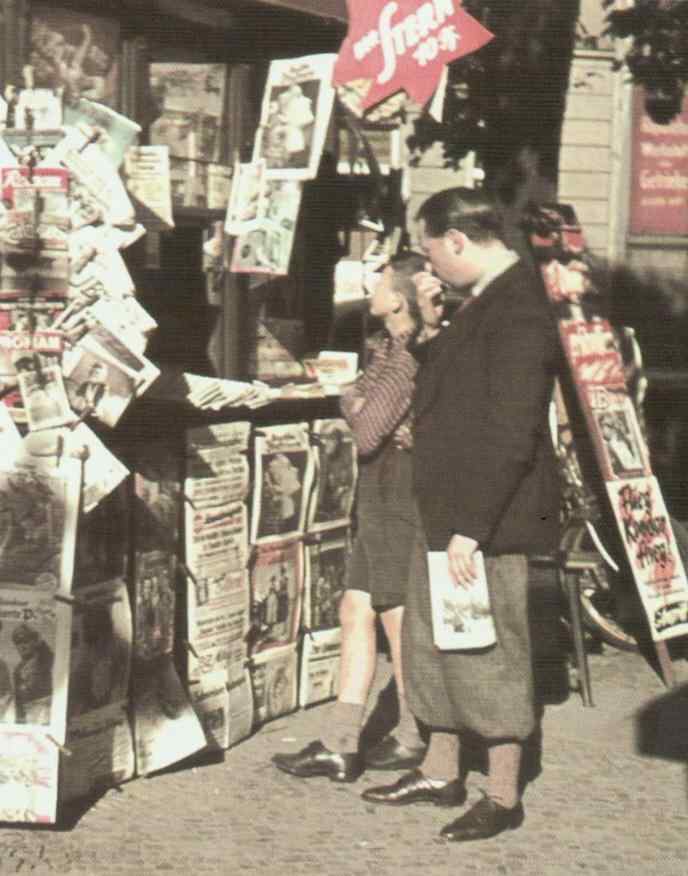
NAZI Media and Propaganda

Figure 1.--Germany before the NAZI seizure of power had one of the livliest, freest, and largest media complex in Europe. Here we see a Berlin newstand in 1933. Goebels was not at first pleased with the appointmentm desiring a more prestigious post. Hitler in retrospect could not have chosen a better minister to gain control over the German press and media. The apparent ease with which Goebbels tamed the vibrant, if quarelsome, German press was startling. The only newspaper I can decypher is "Der Stern". 10 Pf. above the heads of the boys (in red), which still is a German magazine today. At that time the price was 10 Pfennige (10 pennies).
|
|
Germany before the NAZI seizure of power had one of the livliest, freest, and largest media complex in Europe. There was a wide spectrum of newspapers and magazines as well as a major film industry. Virtually every conceivable politicial, economic, and social opinion was aired in the press. Most of what the NAZIs would do was predicted in the German press before 1933. Only the full dimensions of the Hollocaust was not imagined. Chancellor Hitler chose Dr. Paul Joseph Goebbels as his Minister of Propaganda and Public Enlightenment. Goebels was not at first pleased with the appointmentm desiring a more prestigious post. Hitler in retrospect could not have chosen a better minister to gain control over the German press and media. Goebbels was quoted before the NAZI seizure of power as saying, nothing was so good for a hostile editor as "one litre of castor oil". This was actually a measure that was used by the Fascists in Italy. When the opening of Daccau, however, Goebbels and the NAZIs had even more persuasive measures at their disposal. Goebbels as minister moved to gain control over the press and media which ensured that the extra-legal actions being taken were not question or even not fully reported. The apparent ease with which Goebbels tamed the vibrant, if quarelsome German press was starteling. Goebbels used a mix of force and persuasion to achieve his goals. Goebbels set out to deal with stridently anti-NAZI journalists. He gained control over journalists through a law that that prohibited individuals from pursuing journalism unless they were menbers of the NAZI association of journalists. Violators were prosecuted criminally. Then Goebbels seized effective control of German's two largest news services (the Telegraphen-Union and Wolff's Telegraph Bureau) and merged them (December 1933). ["Press"] There were more subtle ways of dealing with most other journalists. We note "conventions" organized for provincial journalists that wre essentially indocrination sessions on the news policies of the Propaganda Minisyry. [Lochner, p. 19.]
Sources
Lochner, Ludwig. ed. The Goebbels Diaries, 1942-1943 (Doubleday: New York, 1948), 566p.
"Press: Nazi Merger" Time (December 11, 1933).
HBC

Navigate the Boys' Historical Clothing Web Site:
[Return to Main NAZI interegnum page]
[Return to Main NAZI government page]
[Return to Main NAZI page]
[Return to Main World War II page]
[Introduction]
[Activities]
[Biographies]
[Chronology]
[Clothing styles]
[Countries]
[Bibliographies]
[Contributions]
[FAQs]
[Glossaries]
[Images]
[Links]
[Registration]
[Tools]
[Boys' Clothing Home]
Created: 6:11 PM 9/17/2009
Last updated: 8:09 PM 9/21/2009



